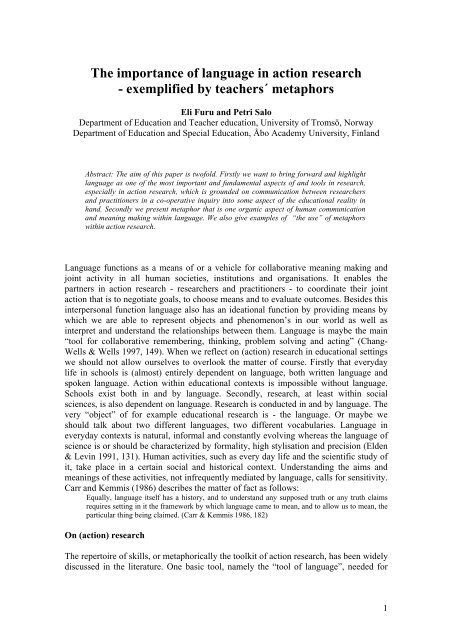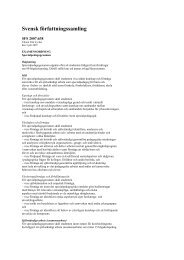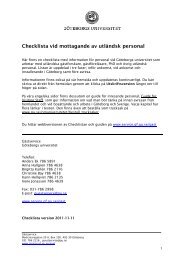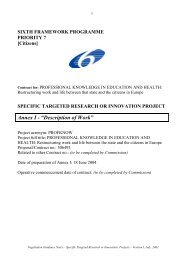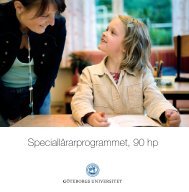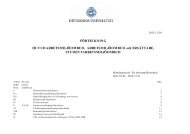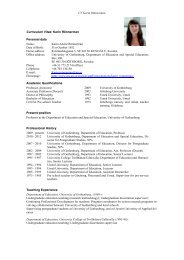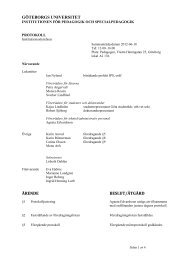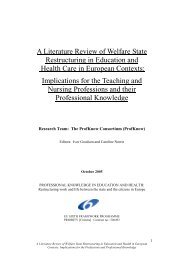The importance of language in action research
The importance of language in action research
The importance of language in action research
You also want an ePaper? Increase the reach of your titles
YUMPU automatically turns print PDFs into web optimized ePapers that Google loves.
<strong>The</strong> <strong>importance</strong> <strong>of</strong> <strong>language</strong> <strong>in</strong> <strong>action</strong> <strong>research</strong><br />
- exemplified by teachers´ metaphors<br />
Eli Furu and Petri Salo<br />
Department <strong>of</strong> Education and Teacher education, University <strong>of</strong> Tromsö, Norway<br />
Department <strong>of</strong> Education and Special Education, Åbo Academy University, F<strong>in</strong>land<br />
Abstract: <strong>The</strong> aim <strong>of</strong> this paper is tw<strong>of</strong>old. Firstly we want to br<strong>in</strong>g forward and highlight<br />
<strong>language</strong> as one <strong>of</strong> the most important and fundamental aspects <strong>of</strong> and tools <strong>in</strong> <strong>research</strong>,<br />
especially <strong>in</strong> <strong>action</strong> <strong>research</strong>, which is grounded on communication between <strong>research</strong>ers<br />
and practitioners <strong>in</strong> a co-operative <strong>in</strong>quiry <strong>in</strong>to some aspect <strong>of</strong> the educational reality <strong>in</strong><br />
hand. Secondly we present metaphor that is one organic aspect <strong>of</strong> human communication<br />
and mean<strong>in</strong>g mak<strong>in</strong>g with<strong>in</strong> <strong>language</strong>. We also give examples <strong>of</strong> “the use” <strong>of</strong> metaphors<br />
with<strong>in</strong> <strong>action</strong> <strong>research</strong>.<br />
Language functions as a means <strong>of</strong> or a vehicle for collaborative mean<strong>in</strong>g mak<strong>in</strong>g and<br />
jo<strong>in</strong>t activity <strong>in</strong> all human societies, <strong>in</strong>stitutions and organisations. It enables the<br />
partners <strong>in</strong> <strong>action</strong> <strong>research</strong> - <strong>research</strong>ers and practitioners - to coord<strong>in</strong>ate their jo<strong>in</strong>t<br />
<strong>action</strong> that is to negotiate goals, to choose means and to evaluate outcomes. Besides this<br />
<strong>in</strong>terpersonal function <strong>language</strong> also has an ideational function by provid<strong>in</strong>g means by<br />
which we are able to represent objects and phenomenon’s <strong>in</strong> our world as well as<br />
<strong>in</strong>terpret and understand the relationships between them. Language is maybe the ma<strong>in</strong><br />
“tool for collaborative remember<strong>in</strong>g, th<strong>in</strong>k<strong>in</strong>g, problem solv<strong>in</strong>g and act<strong>in</strong>g” (Chang-<br />
Wells & Wells 1997, 149). When we reflect on (<strong>action</strong>) <strong>research</strong> <strong>in</strong> educational sett<strong>in</strong>gs<br />
we should not allow ourselves to overlook the matter <strong>of</strong> course. Firstly that everyday<br />
life <strong>in</strong> schools is (almost) entirely dependent on <strong>language</strong>, both written <strong>language</strong> and<br />
spoken <strong>language</strong>. Action with<strong>in</strong> educational contexts is impossible without <strong>language</strong>.<br />
Schools exist both <strong>in</strong> and by <strong>language</strong>. Secondly, <strong>research</strong>, at least with<strong>in</strong> social<br />
sciences, is also dependent on <strong>language</strong>. Research is conducted <strong>in</strong> and by <strong>language</strong>. <strong>The</strong><br />
very “object” <strong>of</strong> for example educational <strong>research</strong> is - the <strong>language</strong>. Or maybe we<br />
should talk about two different <strong>language</strong>s, two different vocabularies. Language <strong>in</strong><br />
everyday contexts is natural, <strong>in</strong>formal and constantly evolv<strong>in</strong>g whereas the <strong>language</strong> <strong>of</strong><br />
science is or should be characterized by formality, high stylisation and precision (Elden<br />
& Lev<strong>in</strong> 1991, 131). Human activities, such as every day life and the scientific study <strong>of</strong><br />
it, take place <strong>in</strong> a certa<strong>in</strong> social and historical context. Understand<strong>in</strong>g the aims and<br />
mean<strong>in</strong>gs <strong>of</strong> these activities, not <strong>in</strong>frequently mediated by <strong>language</strong>, calls for sensitivity.<br />
Carr and Kemmis (1986) describes the matter <strong>of</strong> fact as follows:<br />
Equally, <strong>language</strong> itself has a history, and to understand any supposed truth or any truth claims<br />
requires sett<strong>in</strong>g <strong>in</strong> it the framework by which <strong>language</strong> came to mean, and to allow us to mean, the<br />
particular th<strong>in</strong>g be<strong>in</strong>g claimed. (Carr & Kemmis 1986, 182)<br />
On (<strong>action</strong>) <strong>research</strong><br />
<strong>The</strong> repertoire <strong>of</strong> skills, or metaphorically the toolkit <strong>of</strong> <strong>action</strong> <strong>research</strong>, has been widely<br />
discussed <strong>in</strong> the literature. One basic tool, namely the “tool <strong>of</strong> <strong>language</strong>”, needed for<br />
1
communication with<strong>in</strong> <strong>action</strong> <strong>research</strong>, seem however to be miss<strong>in</strong>g. Or maybe it would<br />
be more accurate to state that the <strong>action</strong> <strong>research</strong> toolkit seem to be defective when it<br />
comes to systematic reflections on the mean<strong>in</strong>g and <strong>importance</strong> <strong>of</strong> <strong>language</strong>. <strong>The</strong><br />
<strong>language</strong> aspect, referr<strong>in</strong>g to the fundamental role <strong>of</strong> <strong>language</strong> with<strong>in</strong> <strong>action</strong> <strong>research</strong><br />
seem to have been noticed ma<strong>in</strong>ly with<strong>in</strong> the postmodernists and poststructuralists<br />
conceptions <strong>of</strong> <strong>action</strong> <strong>research</strong>, <strong>in</strong> connection with for example the idea <strong>of</strong> discourses<br />
(e.g. Brown & Jones 2001). Language, metaphors, narratives and discourse form the<br />
central elements <strong>of</strong> postmodern epistemology. <strong>The</strong> start<strong>in</strong>g po<strong>in</strong>t and the focus is, not<br />
the f<strong>in</strong>al and overarch<strong>in</strong>g truths communicated through a scientific <strong>language</strong> alienated<br />
from everyday practice and problems, but short and little stories – narratives. <strong>The</strong>y<br />
reflect for example a certa<strong>in</strong> group <strong>of</strong> practitioners (e.g. teachers´) way <strong>of</strong> mak<strong>in</strong>g<br />
mean<strong>in</strong>g and organiz<strong>in</strong>g their <strong>action</strong>s <strong>in</strong> a certa<strong>in</strong> social reality. Rich storytell<strong>in</strong>g and<br />
detailed narratives as illustrations <strong>of</strong> the particularity embedded <strong>in</strong> specific cases can be<br />
used to test the validity <strong>of</strong> general scientific laws (Greenwood & Lev<strong>in</strong> 1998, 123-125;<br />
Jenn<strong>in</strong>gs & Graham 1996, 169). A postmodernist perspective might, accord<strong>in</strong>g to<br />
Jenn<strong>in</strong>gs and Graham (ibid. 171), require the <strong>action</strong> <strong>research</strong>er to both “consider<br />
mean<strong>in</strong>g <strong>in</strong> terms <strong>of</strong> relations <strong>of</strong> struggle embodied <strong>in</strong> everyday practice” as well as to<br />
view his <strong>action</strong>s <strong>in</strong> relation to “local contexts”. Action <strong>research</strong> can be looked at as a<br />
specific discourse. Action <strong>research</strong>, when looked at from both the <strong>research</strong>ers and the<br />
practitioners’ po<strong>in</strong>t <strong>of</strong> view is constituted by an identifiable narrative or story. It<br />
challenges the traditional ways <strong>of</strong> mak<strong>in</strong>g sense <strong>of</strong> <strong>research</strong> for example by hav<strong>in</strong>g rules<br />
and metaphors <strong>of</strong> it’s own (ibid. 172).<br />
Reason and Bradbury (2001) reflect on the <strong>in</strong>terest <strong>in</strong> <strong>language</strong> <strong>in</strong> the light <strong>of</strong> the<br />
l<strong>in</strong>guistic and cognitive turn with<strong>in</strong> social sciences s<strong>in</strong>ce the 1960’s. <strong>The</strong> focus is ma<strong>in</strong>ly<br />
on the role <strong>of</strong> <strong>language</strong> <strong>in</strong> the cognitive construction and presentation <strong>of</strong> the reality and<br />
the world, less on the fact that the constructions and presentations <strong>research</strong>ers and<br />
practitioners hold has to be communicated <strong>in</strong> some way. <strong>The</strong>y admit the great<br />
<strong>importance</strong> <strong>of</strong> <strong>language</strong> <strong>in</strong> the process <strong>of</strong> creat<strong>in</strong>g shared realities with<strong>in</strong> <strong>action</strong> <strong>research</strong>,<br />
especially when the emphasis is on develop<strong>in</strong>g democratic forms <strong>of</strong> knowledge. But<br />
they f<strong>in</strong>d the coupl<strong>in</strong>g between the concern with discourses, texts and narratives and the<br />
knowledge-on-<strong>action</strong> needed <strong>in</strong> successful <strong>action</strong> <strong>research</strong> loose. <strong>The</strong>y summarize their<br />
viewpo<strong>in</strong>t <strong>in</strong> a follow<strong>in</strong>g way:<br />
We need to f<strong>in</strong>d a way <strong>of</strong> acknowledg<strong>in</strong>g the lessons <strong>of</strong> the l<strong>in</strong>guistic turn while not ignor<strong>in</strong>g the<br />
deeper structures <strong>of</strong> reality, and propose a more creative and constructive worldview can be based<br />
on the metaphor <strong>of</strong> participation. (Reason & Bradbury 2001, emphasis added)<br />
Scientific rigor and <strong>action</strong> <strong>in</strong> everyday life, can be looked at as two socially created and<br />
preserved realities, differ<strong>in</strong>g from each other both consider<strong>in</strong>g the methods by which<br />
they are created and consider<strong>in</strong>g the formal presentation <strong>of</strong> them. <strong>The</strong> presentation and<br />
communication <strong>of</strong> the “two worlds or realities” dur<strong>in</strong>g <strong>action</strong> <strong>research</strong> is highly<br />
dependent on <strong>language</strong>. Language is one <strong>of</strong> the fundamental, if not the most<br />
fundamental elements that help a group or a community <strong>of</strong> <strong>action</strong> <strong>research</strong>ers, firstly to<br />
construct and make sense <strong>of</strong> their own <strong>research</strong> activities, and secondly to communicate<br />
with<strong>in</strong> and make sense <strong>of</strong> the social reality they are <strong>in</strong>volved and engaged <strong>in</strong> dur<strong>in</strong>g<br />
“<strong>action</strong> <strong>research</strong>”. Success, referr<strong>in</strong>g both to true participation and mean<strong>in</strong>gful <strong>action</strong>, is<br />
<strong>in</strong> many ways dependent on how well a <strong>action</strong> <strong>research</strong>er is able to construct and share a<br />
common <strong>language</strong> with the practitioners <strong>in</strong>volved (Jenn<strong>in</strong>gs & Graham 1996, 172).<br />
2
One crucial start<strong>in</strong>g po<strong>in</strong>t with<strong>in</strong> <strong>action</strong> <strong>research</strong>, the prerequisite for <strong>action</strong>, is to both<br />
look at and understand the social reality under scrut<strong>in</strong>y from the viewpo<strong>in</strong>t <strong>of</strong> the<br />
practitioner (Nagy Hesse-Biber & Leavy 2004, 134). An <strong>action</strong> <strong>research</strong>er has to gettogether<br />
with the practitioners. Miller and Crabtree (2004, 187) describe this gettogether<br />
as a conversational <strong>research</strong> and <strong>action</strong> journey constituted by certa<strong>in</strong> rules <strong>of</strong><br />
which some are given and some have to be constantly re-negotiated throughout the<br />
journey. Reason (1999) calls this ´journey´ a co-operative <strong>in</strong>quiry, which refers to a way<br />
<strong>of</strong> work<strong>in</strong>g with other people with similar k<strong>in</strong>ds <strong>of</strong> concerns and <strong>in</strong>terests. <strong>The</strong> aim <strong>of</strong><br />
this <strong>in</strong>quiry is; firstly to understand each other’s worlds, make sense <strong>of</strong> them and<br />
elaborate new and creative ways <strong>of</strong> comprehend<strong>in</strong>g these worlds, and secondly to learn<br />
to act <strong>in</strong> a way that leads to some k<strong>in</strong>d <strong>of</strong> improvement. One could conclude this by<br />
stat<strong>in</strong>g that the basis, the means and the end as well as the outmost challenge <strong>of</strong> <strong>action</strong><br />
<strong>research</strong> is the meet<strong>in</strong>g <strong>of</strong> two “worlds”, two different traditions, perspectives or<br />
frameworks on human life and existence.<br />
Elden and Lev<strong>in</strong> (1991, 129-132), when present<strong>in</strong>g participatory <strong>action</strong> <strong>research</strong>,<br />
describe the process <strong>of</strong> <strong>action</strong> <strong>research</strong> as collaboration between practitioners and<br />
<strong>research</strong>ers with the aim <strong>of</strong> co-creat<strong>in</strong>g a local theory. This local theory is based on two<br />
different frameworks, the practitioners’ framework, which is implicit, <strong>in</strong>dividual and<br />
fragmented, and the <strong>research</strong>ers theory based framework. <strong>The</strong> concept <strong>of</strong> framework is<br />
used to refer to a certa<strong>in</strong> way <strong>of</strong> understand<strong>in</strong>g, a cognitive map or a <strong>language</strong>. But<br />
maybe one should try to make a dist<strong>in</strong>ction between the construction and development<br />
<strong>of</strong> a cognitive framework and the processes by which this framework is communicated<br />
dur<strong>in</strong>g <strong>action</strong> <strong>research</strong>. Both aspects are dependent on <strong>language</strong> by which the content<br />
and the characteristics <strong>of</strong> one’s framework are communicated. <strong>The</strong> richness and quality<br />
<strong>of</strong> participatory <strong>action</strong> <strong>research</strong> seem to be dependent on how well practitioners and<br />
<strong>research</strong>ers manage to play their differ<strong>in</strong>g frameworks aga<strong>in</strong>st each other, understand<br />
each other <strong>in</strong> order to create an amalgamation, mutually created and accepted local<br />
theory as a basis for <strong>action</strong>.<br />
<strong>The</strong> social reality called <strong>action</strong> <strong>research</strong> is impregnated with metaphors. Maybe we<br />
should look at the concept ´<strong>action</strong> <strong>research</strong>´ as a metaphor. It is <strong>in</strong> many ways as<br />
explanatory and misguid<strong>in</strong>g as metaphors usually are. <strong>The</strong> <strong>in</strong>tensive use <strong>of</strong> metaphors<br />
with<strong>in</strong> a certa<strong>in</strong> social reality, for example with<strong>in</strong> a certa<strong>in</strong> field <strong>of</strong> <strong>research</strong>, might be<br />
<strong>in</strong>terpreted <strong>in</strong> many different ways; as a sign <strong>of</strong> uncerta<strong>in</strong>ty, dynamic evolvement or<br />
complexity. <strong>The</strong> <strong>in</strong>tensive use <strong>of</strong> metaphors when describ<strong>in</strong>g the role and mission <strong>of</strong> an<br />
<strong>action</strong> <strong>research</strong>er is a sign <strong>of</strong> someth<strong>in</strong>g. Why don’t we simply call <strong>action</strong> <strong>research</strong>er as<br />
an <strong>action</strong> <strong>research</strong>er; why do we have to use metaphors like change catalysts, agent,<br />
detective, technician, tra<strong>in</strong>er, therapist, critical friend, the friendly outsider, chameleon<br />
or ropewalker (e.g. Greenwood & Lev<strong>in</strong> 1998, 104-108; Salo 2004, 81)<br />
On metaphors<br />
Metaphors, as one <strong>of</strong> the tools with<strong>in</strong> rhetoric’s, represent a figurative use <strong>of</strong> <strong>language</strong>.<br />
<strong>The</strong>y are used <strong>in</strong> order to communicate specific features <strong>of</strong> the culture with<strong>in</strong> a certa<strong>in</strong><br />
field <strong>of</strong> activity or with<strong>in</strong> certa<strong>in</strong> k<strong>in</strong>ds <strong>of</strong> organizations (e.g. schools) as well specific<br />
features <strong>of</strong> an <strong>in</strong>dividual’s way <strong>of</strong> understand<strong>in</strong>g and mak<strong>in</strong>g mean<strong>in</strong>g <strong>of</strong> his life, his<br />
world and his thoughts. <strong>The</strong> use <strong>of</strong> a metaphor is based on comparison or analogy<br />
3
etween two, at a first glance separate terms, l<strong>in</strong>guistic frameworks or doma<strong>in</strong>s.<br />
Metaphors are mostly used to describe or expla<strong>in</strong> a phenomenon, which is unfamiliar or<br />
complex by compar<strong>in</strong>g it with some other phenomenon that is supposed to be familiar<br />
or simple. <strong>The</strong>refore, the use <strong>of</strong> a metaphor is based on the likeness or the unlikeness <strong>of</strong><br />
two phenomenon’s or between two separate doma<strong>in</strong>s (e.g. C<strong>of</strong>fey & Atk<strong>in</strong>son 1996, 85;<br />
Proctor 1991, 63-64). Lak<strong>of</strong>f and Johnson (1980, 5), who claim that human th<strong>in</strong>k<strong>in</strong>g is<br />
essentially metaphorical, def<strong>in</strong>e metaphor as follows: “<strong>The</strong> essence <strong>of</strong> metaphor is<br />
understand<strong>in</strong>g and experienc<strong>in</strong>g one k<strong>in</strong>d <strong>of</strong> th<strong>in</strong>g <strong>in</strong> terms <strong>of</strong> another.”<br />
<strong>The</strong> very idea <strong>of</strong> a metaphor is to focus, underl<strong>in</strong>e and demonstrate a certa<strong>in</strong> aspect <strong>of</strong> a<br />
phenomenon experienced as unfamiliar, complex or complicated - beyond the ord<strong>in</strong>ary<br />
and well-known words or concepts. But a metaphor has it drawbacks. Instead <strong>of</strong><br />
underl<strong>in</strong><strong>in</strong>g a po<strong>in</strong>t or mak<strong>in</strong>g th<strong>in</strong>gs clearer it can be perplex<strong>in</strong>g and mislead<strong>in</strong>g. <strong>The</strong><br />
political function <strong>of</strong> the metaphor relies on the aspiration <strong>of</strong> underl<strong>in</strong><strong>in</strong>g and focus<strong>in</strong>g<br />
ideas that are regarded as desirable, and furthermore on the potential that metaphors also<br />
hold, namely to disregard certa<strong>in</strong> aspects <strong>of</strong> a phenomenon. One can assume that use <strong>of</strong><br />
metaphors by practitioners <strong>in</strong> a certa<strong>in</strong> social context reveals someth<strong>in</strong>g about the<br />
characteristics <strong>of</strong> the specific context. Metaphors are grounded <strong>in</strong> traditions, common<br />
experiences, specific values, shared knowledge and collective identities. A <strong>research</strong>er<br />
can use metaphors as a short cut, when striv<strong>in</strong>g for to identify the cultural features,<br />
shared understand<strong>in</strong>gs or situated realities <strong>of</strong> a group <strong>of</strong> practitioners <strong>in</strong> a certa<strong>in</strong> social<br />
context (C<strong>of</strong>fey & Atk<strong>in</strong>son 1996, 86). Metaphors can be used both as a means and as a<br />
method. One can identify metaphors <strong>in</strong> the everyday <strong>language</strong> <strong>of</strong> the practitioners or ask<br />
the practitioners to describe aspects <strong>of</strong> their every activities by us<strong>in</strong>g metaphors (Salo<br />
2002, 210-214). With<strong>in</strong> science metaphors are <strong>of</strong>ten used <strong>in</strong> a heuristic and imag<strong>in</strong>ative<br />
way, to describe and label ideas, thoughts, concepts, models or perspectives that are<br />
new and evolv<strong>in</strong>g. Miles and Huberman (1984, 221) identify several possibilities for<br />
us<strong>in</strong>g metaphors with<strong>in</strong> qualitative <strong>research</strong>. Researchers can use metaphors besides as<br />
data-reduc<strong>in</strong>g, pattern-mak<strong>in</strong>g and decentr<strong>in</strong>g devices as ways <strong>of</strong> connect<strong>in</strong>g f<strong>in</strong>d<strong>in</strong>gs to<br />
theory that is to bridge the “gap” between practice and theory.<br />
Quite <strong>of</strong>ten, the metaphors used <strong>in</strong> educational <strong>research</strong> derive from nature, technology<br />
or social life at large. Scientific concepts are quite seldom used metaphorically, even<br />
though it is possible to f<strong>in</strong>d examples <strong>of</strong> metaphorical use <strong>of</strong> the most fundamental<br />
concepts with<strong>in</strong> scientific <strong>research</strong>. <strong>The</strong> concept <strong>of</strong> ´theory´ seems to have become a<br />
<strong>research</strong> guid<strong>in</strong>g metaphor, k<strong>in</strong>d <strong>of</strong> a root metaphor, <strong>in</strong> studies <strong>of</strong> teacher’s cognitions.<br />
<strong>The</strong> use <strong>of</strong> theory as a metaphor is <strong>of</strong>ten extended by complement<strong>in</strong>g it with prefixes<br />
like subjective, private, personal or naïve. Bromme (2003) discuss <strong>in</strong> detail the use <strong>of</strong><br />
the metaphor ´theory´ as conceptualisation <strong>of</strong> the <strong>action</strong>-relevant knowledge teachers’<br />
rely on when they act <strong>in</strong> their classrooms. But he seems not to be comfortable with the<br />
metaphorical use <strong>of</strong> the concept <strong>of</strong> theory. His ma<strong>in</strong> objection aga<strong>in</strong>st the use <strong>of</strong> theory<br />
as a metaphor is the difference between the two doma<strong>in</strong>s <strong>in</strong> question, namely the<br />
doma<strong>in</strong> <strong>of</strong> scientific <strong>research</strong> based on certa<strong>in</strong> criteria <strong>of</strong> rationality and the doma<strong>in</strong> <strong>of</strong><br />
practice with certa<strong>in</strong> criteria <strong>of</strong> effective <strong>action</strong>. <strong>The</strong> challenge <strong>of</strong> handl<strong>in</strong>g this<br />
difference is one <strong>of</strong> the ma<strong>in</strong> challenges also <strong>in</strong> <strong>action</strong> <strong>research</strong>. One <strong>of</strong> the most<br />
fundamental criteria <strong>of</strong> rationality <strong>in</strong> scientific <strong>research</strong> is the separation <strong>of</strong> descriptiveanalytical<br />
statements, referr<strong>in</strong>g to observations <strong>of</strong> th<strong>in</strong>gs as they are from normativeprescriptive<br />
statements, referr<strong>in</strong>g to for example decisions on how th<strong>in</strong>gs should be<br />
4
done <strong>in</strong> order to be considered as effective. Consequently, when a teacher confront<strong>in</strong>g a<br />
restless group <strong>of</strong> students <strong>in</strong> her classroom does not have, before mak<strong>in</strong>g a decision how<br />
to handle this, the possibility to make systematic and analytical observations <strong>of</strong> all the<br />
variables <strong>in</strong> hand as well as the coupl<strong>in</strong>gs between these, the ´theory´ as a metaphor for<br />
her <strong>action</strong>-related knowledge is <strong>in</strong>appropriate. Even Carr and Kemmis (1986, 189)<br />
reject the idea that teachers´ operate accord<strong>in</strong>g to some k<strong>in</strong>d <strong>of</strong> implicit theories, or<br />
more precisely a certa<strong>in</strong> set <strong>of</strong> pr<strong>in</strong>ciples. Accord<strong>in</strong>g to them teachers “act<strong>in</strong>g” is largely<br />
a product <strong>of</strong> unrecognised customs, habits, coercion and ideologies. Our counterargument<br />
is based on the very idea <strong>of</strong> metaphors. <strong>The</strong>y function by shedd<strong>in</strong>g light on<br />
certa<strong>in</strong> aspects <strong>of</strong> reality while leav<strong>in</strong>g other aspects, maybe not totally <strong>in</strong> the darkness,<br />
but <strong>in</strong> the shadow anyway. Metaphors, as <strong>research</strong> at large, are and should always be<br />
open-ended, <strong>in</strong> the sense that a hypothesis can be both proved and disproved. <strong>The</strong><br />
function <strong>of</strong> a metaphor, as little as the function <strong>of</strong> a certa<strong>in</strong> scientific theory, is maybe<br />
not to cover everyth<strong>in</strong>g, just to make some crucial connections apparent.<br />
Teachers´ use <strong>of</strong> metaphors after studies <strong>in</strong> Action Learn<strong>in</strong>g<br />
In the follow<strong>in</strong>g we present some examples <strong>of</strong> the different ways that metaphors has<br />
been used for communication dur<strong>in</strong>g and after <strong>action</strong> <strong>research</strong>. We try to look at the use<br />
<strong>of</strong> metaphors from both the <strong>research</strong>ers theoretical po<strong>in</strong>t <strong>of</strong> view and the practitioners’<br />
practical po<strong>in</strong>t <strong>of</strong> view.<br />
<strong>The</strong> Studies <strong>in</strong> Action Learn<strong>in</strong>g<br />
We present two examples <strong>of</strong> teachers‘ use <strong>of</strong> metaphors dur<strong>in</strong>g their studies <strong>in</strong> Action<br />
Learn<strong>in</strong>g. In a period <strong>of</strong> five years, the University <strong>of</strong> Tromsö, Norway, has been<br />
responsible for studies <strong>in</strong> Action Learn<strong>in</strong>g for primary and secondary school teachers <strong>in</strong><br />
Sweden. <strong>The</strong> f<strong>in</strong>al aim <strong>of</strong> the studies was to develop more mean<strong>in</strong>gful learn<strong>in</strong>g<br />
situations for students <strong>in</strong> the classroom sett<strong>in</strong>gs. <strong>The</strong> studies were organised with two<br />
physical meet<strong>in</strong>gs and four videoconferences dur<strong>in</strong>g one year. Between the meet<strong>in</strong>gs,<br />
the teachers´ <strong>in</strong>volved <strong>in</strong> the studies organised group meet<strong>in</strong>gs with their ”critical<br />
friends” <strong>in</strong> order to reflect their experiences from their ”<strong>action</strong>s”. To document what<br />
was happen<strong>in</strong>g <strong>in</strong> the classrooms, the teachers wrote journals with their reflections and<br />
<strong>in</strong>terviewed their students. A close connection between ”learn<strong>in</strong>g at workplace” and<br />
”learn<strong>in</strong>g at university” was emphasized throughout the studies. <strong>The</strong> teacher-students<br />
brought the experiences from their workplaces to the meet<strong>in</strong>gs and shared them with<br />
each other. <strong>The</strong> theories presented by the <strong>research</strong>ers at the University were meant to be<br />
used for reflections on practice. Researchers acted as process facilitators by ask<strong>in</strong>g<br />
reflective questions about the teach<strong>in</strong>g, with the aim <strong>of</strong> forc<strong>in</strong>g the teachers distance<br />
themselves from their immediate experiences.<br />
Action Learn<strong>in</strong>g refers to a systematic, <strong>in</strong>tentional develop<strong>in</strong>g <strong>of</strong> the practice together<br />
with other teachers and <strong>in</strong> partnership with a <strong>research</strong>er. It is <strong>of</strong>ten called “the little<br />
brother <strong>of</strong> <strong>action</strong> <strong>research</strong>” (Tiller 1999). Dur<strong>in</strong>g the study, the teachers started up with a<br />
develop<strong>in</strong>g project –”<strong>action</strong>”- at their workplaces. <strong>The</strong>y begun the process by ask<strong>in</strong>g<br />
themselves one fundamental question; what can I do <strong>in</strong> order to change the social reality<br />
I am <strong>in</strong>volved <strong>in</strong> (Kalleberg 1992). <strong>The</strong>y formulated the complementary questions by<br />
us<strong>in</strong>g their own practice as start<strong>in</strong>g po<strong>in</strong>t. <strong>The</strong> answers were supposed to be found and<br />
5
formulated by <strong>in</strong>quiries <strong>in</strong> their classrooms. <strong>The</strong> <strong>in</strong>quiry processes were organized<br />
accord<strong>in</strong>g to the cycle consist<strong>in</strong>g <strong>of</strong> plann<strong>in</strong>g, act<strong>in</strong>g, observ<strong>in</strong>g and reflect<strong>in</strong>g (Carr &<br />
Kemmis 1986). <strong>The</strong> <strong>action</strong> learn<strong>in</strong>g process was completed by a written rapport from<br />
the <strong>in</strong>quiry where the teachers used theory, both to support but also to open up for new<br />
thoughts about their “<strong>action</strong>s”.<br />
It was quit evident that the teachers participat<strong>in</strong>g <strong>in</strong> the studies <strong>of</strong> Action Learn<strong>in</strong>g were<br />
energetic and enthusiastic. This was to be recognized both <strong>in</strong> their will<strong>in</strong>gness to reflect<br />
on themselves as teachers dur<strong>in</strong>g the studies and the evaluations they wrote afterwards.<br />
<strong>The</strong>y told both that the study <strong>in</strong> Action Learn<strong>in</strong>g had endorsed them to try new ways <strong>of</strong><br />
teach<strong>in</strong>g and that they felt more pr<strong>of</strong>essional and secure as teachers than before. Most <strong>of</strong><br />
the teachers had been work<strong>in</strong>g for about twenty years. But why did these experienced<br />
teachers quite spontaneously come up with <strong>in</strong>terest<strong>in</strong>g and challeng<strong>in</strong>g theoretical<br />
reflections after hav<strong>in</strong>g participated <strong>in</strong> quite short studies <strong>in</strong> Action Learn<strong>in</strong>g To f<strong>in</strong>d<br />
more about what the studies had meant to the teachers, they were <strong>in</strong>terviewed a year<br />
after they had f<strong>in</strong>ished their studies at the University <strong>of</strong> Tromsö. Dur<strong>in</strong>g the <strong>in</strong>terviews<br />
some <strong>of</strong> the teachers used several metaphors when try<strong>in</strong>g to expla<strong>in</strong> the mean<strong>in</strong>g <strong>of</strong><br />
Action Learn<strong>in</strong>g. In the follow<strong>in</strong>g two metaphors, brought forward by Ditte and Eva<br />
(the names are fictitious), will be presented and reflected on.<br />
Ditte<br />
Metaphors generate spontaneously a lot <strong>of</strong> images (Alvesson & Sköldberg 1994, 141).<br />
What images comes up when confront<strong>in</strong>g Ditte’s metaphor “Chisel is much better than<br />
knife” We use a chisel when we want to work with hard material like tree and stone.<br />
Usually we use a hammer together with chisel. Chisel is more specialised for the task to<br />
form someth<strong>in</strong>g very hard. An all-around tool like knife is not sufficient. When a<br />
carpenter has the tool he needs, it is much easier for him to get a good, or <strong>in</strong> other words<br />
a pr<strong>of</strong>essional result. Ditte´s use <strong>of</strong> the metaphors chisel and knife suits corresponds<br />
beautifully with the function <strong>of</strong> a metaphor; a phenomenon that is unfamiliar and<br />
complicated is compared with some other phenomenon that is supposed to be familiar<br />
(Lak<strong>of</strong>f & Johnson 2003).<br />
To understand what Ditte referred to with this metaphor, it is necessary to shortly<br />
describe what happened to Ditte dur<strong>in</strong>g the studies Action Learn<strong>in</strong>g. Ditte was teach<strong>in</strong>g<br />
German <strong>in</strong> secondary school. <strong>The</strong> challenge she confronted was to <strong>in</strong>crease the students<br />
learn<strong>in</strong>g for their own sake and not for the teacher’s. Through the students’ journal<br />
reflections and by <strong>in</strong>terview<strong>in</strong>g them, she <strong>in</strong>creased her understand<strong>in</strong>g <strong>of</strong> how her pupils<br />
were th<strong>in</strong>k<strong>in</strong>g. Dur<strong>in</strong>g this process she developed concepts about students’ way <strong>of</strong><br />
learn<strong>in</strong>g and found also words for describ<strong>in</strong>g this. By document<strong>in</strong>g her reflections, she<br />
found out what she would focus on <strong>in</strong> her daily life <strong>in</strong> the classroom. By us<strong>in</strong>g the<br />
metaphors knife and chisel she communicates someth<strong>in</strong>g about past and present. Studies<br />
<strong>in</strong> Action Learn<strong>in</strong>g had literally provided her with a tool that gave her better<br />
possibilities to act <strong>in</strong> a more satisfactory manner than earlier. What tool is she speak<strong>in</strong>g<br />
about <strong>The</strong> Action Learn<strong>in</strong>g process consists <strong>of</strong> plann<strong>in</strong>g, act<strong>in</strong>g, observ<strong>in</strong>g and<br />
reflection. This <strong>in</strong>quiry has improved her teach<strong>in</strong>g, but has also strengthened her role as<br />
teacher. Through the studies <strong>in</strong> Action Learn<strong>in</strong>g she felt she has got a tool that was more<br />
suitable for her job.<br />
6
Eva<br />
Eva, a teacher <strong>in</strong> a rural primary school, used many metaphors. One <strong>of</strong> them was “ to<br />
w<strong>in</strong>d up the yarns and weave.” What images does this metaphor create When you are<br />
weav<strong>in</strong>g, you use a shuttle to lead a yarn under and over the basic threads <strong>in</strong> the loom. If<br />
you are go<strong>in</strong>g to weave, and all the yarns with different colours are ly<strong>in</strong>g all over the<br />
floor, everyth<strong>in</strong>g is chaotic. You have to beg<strong>in</strong> with w<strong>in</strong>d<strong>in</strong>g the yarns to a ball. <strong>The</strong>n<br />
you can start weav<strong>in</strong>g with those yarns, and weave for example a mat. It is impossible<br />
to weave a mat us<strong>in</strong>g yarns that are ly<strong>in</strong>g all over a table. <strong>The</strong> yarns must be organized,<br />
w<strong>in</strong>ded to a ball, <strong>in</strong> order to be used <strong>in</strong> a loom. When you weave, you create a certa<strong>in</strong><br />
pattern. <strong>The</strong> pattern can be someth<strong>in</strong>g you want to make a copy <strong>of</strong> or you can create<br />
your own pattern dur<strong>in</strong>g the process. Eva had created her own pattern dur<strong>in</strong>g her<br />
weav<strong>in</strong>g. Dur<strong>in</strong>g the years she has been work<strong>in</strong>g as teacher, she has collected many<br />
“threads”. Now she had the chance to w<strong>in</strong>d them up and use a loom to weave them to a<br />
pattern.<br />
What was the context for Eva’s metaphor She had been th<strong>in</strong>k<strong>in</strong>g about the fact that<br />
when pupils were work<strong>in</strong>g with mathematic tasks, they got too little time to solve<br />
problems. She wanted to f<strong>in</strong>d answer to the question; how can pupils’ reflection dur<strong>in</strong>g<br />
the solv<strong>in</strong>g <strong>of</strong> mathematic tasks become a vehicle for new ways <strong>of</strong> teach<strong>in</strong>g When the<br />
pupils were work<strong>in</strong>g with their tasks <strong>in</strong> mathematics, she asked them what they thought<br />
about problem solv<strong>in</strong>g. Afterwards she wrote down her reflections. <strong>The</strong>n she let the<br />
pupils work with solv<strong>in</strong>g mathematic problems <strong>in</strong>dividually and <strong>in</strong> groups. To<br />
document what was happen<strong>in</strong>g, she taped her conversation with the pupils and asked<br />
them to make notes on their reflections. Gradually she became aware <strong>of</strong> how important<br />
the <strong>language</strong> <strong>in</strong> mathematic is for the pupils. She also found some support for her<br />
hypothesis <strong>in</strong> the literature; that it is important for the pupils to “speak about<br />
mathematic”. Another th<strong>in</strong>g she had noted and reflected on, was how she responded<br />
when the pupils asked for her help. Instead <strong>of</strong> just guid<strong>in</strong>g a pupil to the right answer,<br />
she asked him or her to express his or her own thoughts about the task and the possible<br />
answer.<br />
When Eva was asked about the studies <strong>in</strong> Action Learn<strong>in</strong>g, she said that her way <strong>of</strong><br />
th<strong>in</strong>k<strong>in</strong>g and reflect<strong>in</strong>g had changed. She has had the possibility to get an overview <strong>of</strong><br />
all the threads she had collected dur<strong>in</strong>g her life as teacher. Before the threads are<br />
w<strong>in</strong>ded, we can imag<strong>in</strong>e the chaotic situation with different colours <strong>of</strong> yarns spread<br />
around the floor. <strong>The</strong> teachers’ every day work<strong>in</strong>g experiences could be described<br />
fragmented, <strong>in</strong>coherent broken and messy. Teachers need both time and “space” to<br />
reflect on the activities tak<strong>in</strong>g place with<strong>in</strong> their classrooms (Handal & Lauvås 1999).<br />
Dur<strong>in</strong>g the study, Eva got the time, the physical “space” and colleagues to reflect with.<br />
In her own op<strong>in</strong>ion all the activities a teacher confronts with dur<strong>in</strong>g the work<strong>in</strong>g hours,<br />
e.g. conferences, plans, papers, h<strong>in</strong>dered her to focus the meet<strong>in</strong>g between the teacher<br />
and the pupil <strong>in</strong> the class. She said: “ I have got my voice as pedagogue back.” Dur<strong>in</strong>g<br />
the study she got the chance to ask questions about own practice, reflect about it and<br />
present her thoughts <strong>in</strong> a reflection group where the colleagues <strong>of</strong> her were <strong>in</strong>terested to<br />
set the pupil’s learn<strong>in</strong>g <strong>in</strong> focus. <strong>The</strong> study <strong>in</strong> Action Learn<strong>in</strong>g had also empowered her.<br />
She felt proud and strong and was prepared to express her op<strong>in</strong>ions when discuss<strong>in</strong>g<br />
with colleges. Her conclusion was; “I hold my head up high”.<br />
7
Reflections on the metaphors<br />
Both <strong>of</strong> the teachers´ metaphors presented above are somehow traditional, they orig<strong>in</strong>ate<br />
from and refer to handicraft. Especially the second example is <strong>in</strong>terest<strong>in</strong>g and<br />
challeng<strong>in</strong>g because <strong>of</strong> the clash or the bridg<strong>in</strong>g <strong>of</strong> two different doma<strong>in</strong>s, mathematics<br />
as a theoretical subject and weav<strong>in</strong>g as a practical activity. It represents a metaphor <strong>in</strong><br />
its true mean<strong>in</strong>g. But what was the function <strong>of</strong> these metaphors for the teachers <strong>in</strong><br />
question Why did they use them Did they merely f<strong>in</strong>d an imag<strong>in</strong>ative <strong>language</strong>, that it<br />
suitable metaphors, to articulate some k<strong>in</strong>d <strong>of</strong> tacit knowledge emanat<strong>in</strong>g from their<br />
long experience <strong>of</strong> teach<strong>in</strong>g and confront<strong>in</strong>g students Was it just because <strong>of</strong> the Action<br />
Learn<strong>in</strong>g project (academia meet<strong>in</strong>g practice) they came up with these metaphors And<br />
f<strong>in</strong>ally, can the metaphors the two teachers <strong>in</strong> question used be understood as<br />
communicat<strong>in</strong>g a local theory<br />
One <strong>of</strong> the functions <strong>of</strong> metaphors is to build bridges between the old condition and the<br />
new one. Daily words tell us only what we already know. Metaphors and a creative use<br />
<strong>of</strong> them helps us to grasp new phenomenon’s (Lak<strong>of</strong>f & Johnson 2003,179). When Eva<br />
and Fanny were to describe what the studies <strong>in</strong> Action Learn<strong>in</strong>g had meant to them,<br />
they chose to use metaphors. <strong>The</strong>y could easily describe the practical aspects <strong>of</strong> the<br />
<strong>action</strong> learn<strong>in</strong>g process, but to be able to tread the “jungle <strong>of</strong> theory” they had to use<br />
metaphors. <strong>The</strong> reason for this may be that it was to complex to describe precisely what<br />
it had meant to their role as teacher. Another reason may be that the metaphors made it<br />
possible to build a bridge between the teachers’ practical life and “jungle <strong>of</strong><br />
abstr<strong>action</strong>s” where the <strong>language</strong> is “the practice”.<br />
<strong>The</strong> process <strong>of</strong> <strong>action</strong> <strong>research</strong> as true collaboration between practitioners and<br />
<strong>research</strong>ers with the aim <strong>of</strong> co-creat<strong>in</strong>g a local theory requires, <strong>in</strong> Elden and Lev<strong>in</strong>s<br />
(1991, 134) words a cogenerative dialogue. Teacher is the expert <strong>in</strong> the classroom and<br />
know how get th<strong>in</strong>gs done. But her knowledge-on-<strong>action</strong> tends to be <strong>in</strong>dividual, nonsystematic<br />
and unreflected upon. <strong>The</strong> <strong>research</strong>er has tra<strong>in</strong><strong>in</strong>g <strong>in</strong> systematic <strong>in</strong>quiry and<br />
the expertise <strong>in</strong> handl<strong>in</strong>g theories and creat<strong>in</strong>g new knowledge. What happened <strong>in</strong> the<br />
course <strong>of</strong> cogenerative dialogues dur<strong>in</strong>g studies <strong>in</strong> Action Learn<strong>in</strong>g Teachers learned<br />
how to carry out systematic <strong>in</strong>quiries <strong>in</strong> the classroom. <strong>The</strong>y wrote journals about the<br />
<strong>in</strong>quiries they conducted <strong>in</strong> the school and were challenged to use theories to reflect on<br />
what had happened <strong>in</strong> the classroom and the lessons to be learned from these <strong>in</strong>quiries.<br />
<strong>The</strong> practitioner and the <strong>research</strong>er met <strong>in</strong> a dialogue about both the learn<strong>in</strong>g-process <strong>of</strong><br />
the pupils and the learn<strong>in</strong>g-process <strong>of</strong> the teachers as practitioners. <strong>The</strong>se new<br />
frameworks could then be used a basis for a new <strong>action</strong> <strong>in</strong> practise. For Eva and Fanny<br />
the metaphors represent k<strong>in</strong>d a local theory when as a pr<strong>of</strong>essional teachers confront the<br />
demand<strong>in</strong>g question: What can I do to improve my practice <strong>in</strong> school Fanny<br />
manifested that she had found a new tool, chisel <strong>in</strong>stead <strong>of</strong> knife, more suitable for her<br />
task as a teacher. Eva has realised that the <strong>action</strong> learn<strong>in</strong>g process had provided her with<br />
a chance to make questions about her teach<strong>in</strong>g. “W<strong>in</strong>d<strong>in</strong>g up the yarns and weave”<br />
referred to systematic use methods to f<strong>in</strong>d out what role the role and <strong>importance</strong> <strong>of</strong><br />
<strong>language</strong> played <strong>in</strong> mathematic lessons. <strong>The</strong> metaphors <strong>in</strong> hand shed a light on different<br />
aspects <strong>of</strong> what the studies <strong>in</strong> Action Learn<strong>in</strong>g had meant to them as teacher. <strong>The</strong>y<br />
seemed also to be able to put forward alocal theory as basis for new, improved <strong>action</strong>s.<br />
8
References<br />
Alvesson, M. & Sköldberg, K. (1994). Tolkn<strong>in</strong>g och reflektion. Vetenskapsfilos<strong>of</strong>i och kvalitativ metod.<br />
[Interpretation and reflection. Philosophy <strong>of</strong> science and the qualitative method] Lund:<br />
Studentlitteratur.<br />
Bromme, R. (2003). On the limitations <strong>of</strong> the theory metaphor for the study <strong>of</strong> teachers´ expert<br />
knowledge. In M. Kompf & P.M. Denicolo (Eds) Teacher th<strong>in</strong>k<strong>in</strong>g twenty years on: Revisit<strong>in</strong>g<br />
persist<strong>in</strong>g problems and advances <strong>in</strong> education. (pp. 283-293). Lisse: Swets & Zeitl<strong>in</strong>ger<br />
Publishers.<br />
Brown, T. & Jones, L. (2001). Action <strong>research</strong> and postmodernism. Congruence and critique.<br />
Buck<strong>in</strong>gham: Open University Press.<br />
Carr, W. & Kemmis,S. (1986). Becom<strong>in</strong>g critical. Education, Knowledge and Action Research. London:<br />
<strong>The</strong> Falmer Press<br />
Chang-Wells, G. L. & Wells, G. (1997). Modes <strong>of</strong> discourse for liv<strong>in</strong>g, learn<strong>in</strong>g and teach<strong>in</strong>g. In S.<br />
Holl<strong>in</strong>gsworth (Ed). International <strong>action</strong> <strong>research</strong>. A casebook for educational reform (pp. 147-<br />
156). London: Falmer Press.<br />
C<strong>of</strong>fey, A. & Atk<strong>in</strong>son, P. (1996). Mak<strong>in</strong>g sense <strong>of</strong> qualitative <strong>research</strong>. Comple-mentarry <strong>research</strong><br />
strategies. California: Sage Publications.<br />
Elden, M. & Lev<strong>in</strong>, M. (1991). Cogenerative learn<strong>in</strong>g. Br<strong>in</strong>g<strong>in</strong>g participation <strong>in</strong>to <strong>action</strong> <strong>research</strong>. In W.F.<br />
Whyte. (Ed.) Participatory <strong>action</strong> <strong>research</strong> (pp. 127-142). Newbury Park, California: Sage<br />
Publications.<br />
Greenwood, D. J. & Lev<strong>in</strong>, M. (1998). Introduction to <strong>action</strong> <strong>research</strong>. Social <strong>research</strong> for social change.<br />
London: Sage Publicatons.<br />
Handal.G. & Lauvås, P.(1999) På egne vilkår: en strategi for veiledn<strong>in</strong>g med lærere. [On their own terms:<br />
A strategy for guid<strong>in</strong>g teachers] Oslo: Cappelen Akademisk Forlag.<br />
Jenn<strong>in</strong>gs, L. E. & Graham, A. P. (1996). Expos<strong>in</strong>g discourses trough <strong>action</strong> reserach. In O. Zuber-Skerrit<br />
(Ed.). New directions <strong>in</strong> <strong>action</strong> <strong>research</strong>. (pp. 165-181). London: <strong>The</strong> Falmer Press.<br />
Kalleberg, R (1992) Konstruktiv samfunnsvitenskap. En fagteoretisk plasser<strong>in</strong>g av ”aksjonsforskn<strong>in</strong>g”<br />
[Constructive social science. An identification <strong>of</strong> <strong>action</strong> <strong>research</strong> with<strong>in</strong> a subject field] Oslo:<br />
Universitetet i Oslo, Rapport nr.24 Institutt for sosiologi<br />
Lak<strong>of</strong>f, G. & Johnson, M. (1980). Metaphors we live by. Chicago, London: <strong>The</strong> University <strong>of</strong> Chicago<br />
Press.<br />
Miles, M. B. & Huberman, A. M. (1984). Qualitative data analysis. A sourcebook <strong>of</strong> new methods.<br />
Newbury Park, CA: Sage Publications.<br />
Miller, W.L. & Crabtree, B.F. (2004). Depth Interview<strong>in</strong>g. In S. Nagy Hesse-Biber, S. & P. Leavy. (Eds.)<br />
Approaches to qualitative <strong>research</strong>. A reader on theory and practice. (pp. 185-202) New York,<br />
Oxford: Oxford University Press,.<br />
Nagy Hesse-Biber, S. & Leavy, P. (2004). Inter<strong>action</strong> and positionality with<strong>in</strong> qualitative <strong>research</strong>. In S.<br />
Nagy Hesse-Biber, S. & P. Leavy. Approaches to qualitative <strong>research</strong>. A reader on theory and<br />
practice. (pp. 131-148) New York, Oxford: Oxford University Press.<br />
Proctor, R. F. (1991). Metaphors <strong>of</strong> adult education: Beyond penance toward family. Adult Education<br />
Quarterly, 41, 63-74).<br />
Reason, P. (1999). Integrat<strong>in</strong>g Action and Reflection through Co-operative Inquiry. Retrieved January 16,<br />
2005 from http://www.bath.ac.uk/~mnspwr/paperslist.htm<br />
Reason, P. & Bradbury, H. (2001). Inquiry and Participation <strong>in</strong> Search <strong>of</strong> a World Worthy <strong>of</strong> Human<br />
Aspiration. Retrieved January 16, 2005 from http://www.bath.ac.uk/~mnspwr/paperslist.htm<br />
Salo, P. (2002). Skolan som mikropolitisk organisation – En studie i det som skolan är. [School as a<br />
micropolitical organization: A Study <strong>of</strong> what school really is] Dissertation. Åbo: Åbo Akademis<br />
förlag.<br />
Salo, P. (2004). Metaforen som livboj. Aktionsforskaren i den mikropolitiska skolorganisationen.<br />
[Metaphor as libuoy. Action <strong>research</strong>er meets the micropolitics <strong>of</strong> the school]. In T. Tiller (red.)<br />
Aksjonsforskn<strong>in</strong>g i skole og utdann<strong>in</strong>g. [Action <strong>research</strong> <strong>in</strong> school and education] (pp. 79-97)<br />
Kristiansand: Hoyskoleforlaget..<br />
Tiller, T. (1999): Et forskende partnerskap i skolen. [Research partnership <strong>in</strong> school] Höyskoleforlaget.<br />
Kristiansand<br />
Zeichner, K. (1999): Action <strong>research</strong> and the Preparation <strong>of</strong> Reflective Practitioners Dur<strong>in</strong>g the<br />
Pr<strong>of</strong>essional Practicum: Lessons Learned. International Journal <strong>of</strong> PEPE Inc, 3 (1).<br />
9


